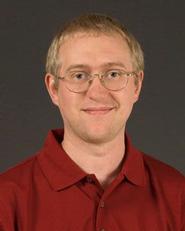
Assistant Professor of Chemistry Adam Van Wynsberghe gave an invited seminar as part of the “Modeling Diffusional Encounter and Subsequent Events Mini-Symposium” held this week at the University of California-San Diego (UCSD).
Van Wynsberghe’s talk was titled “Simulations of ligand binding pathways: directed diffusion with Hamilton College undergraduates” and described the efforts of the Van Wynsberghe lab in understanding how small molecule ligands interact with and bind to neuraminidase, a viral protein that plays an important role in the influenza virus replication cycle. In addition to the seminars, the mini-symposium included a journal review of recent literature and scheduled time to meet with other investigators working in the field including faculty, post-doctoral fellows and graduate students. The mini-symposium was organized by Rommie Amaro, a faculty in UCSD’s Biochemistry and Chemistry departments who collaborates with the Van Wynsberghe group.
The first half of Van Wynsberghe’s seminar detailed the group’s efforts to utilize Brownian dynamics simulations to calculate the rate at which the drugs Tamiflu©, Relenza©, and peramivir, along with the natural substrate sialic acid bound to neuraminidase. Hamilton College students Erica Losito ’12, Carmen Montagnon ’13, Laura Leonard ’11, and Carlos Rico ’10 all contributed to this work. The second half of the seminar described the group’s work in developing a mixed molecular dynamics/Brownian dynamics algorithm to provide more accurate estimations of association rate constants. Student contributions to this work include the efforts of Alvin Wu ’13, Jeremy Adelman ’13, Leah Krause ’14, Dan Mermelstein ’14 and Rebecca Green ’11.
Additional details of the students' research work can be found by clicking these links (2010, 2011 and 2012).
In general, the Van Wynsberghe lab studies protein flexibility and dynamics using a variety of computational and theoretical techniques. The lab’s goals are to develop and utilize molecular simulation methods to investigate biological and biochemical systems from a physical and chemical perspective.
